technical data SKODA CITIGO 2016 1.G Owner's Manual
[x] Cancel search | Manufacturer: SKODA, Model Year: 2016, Model line: CITIGO, Model: SKODA CITIGO 2016 1.GPages: 172, PDF Size: 24.59 MB
Page 4 of 172
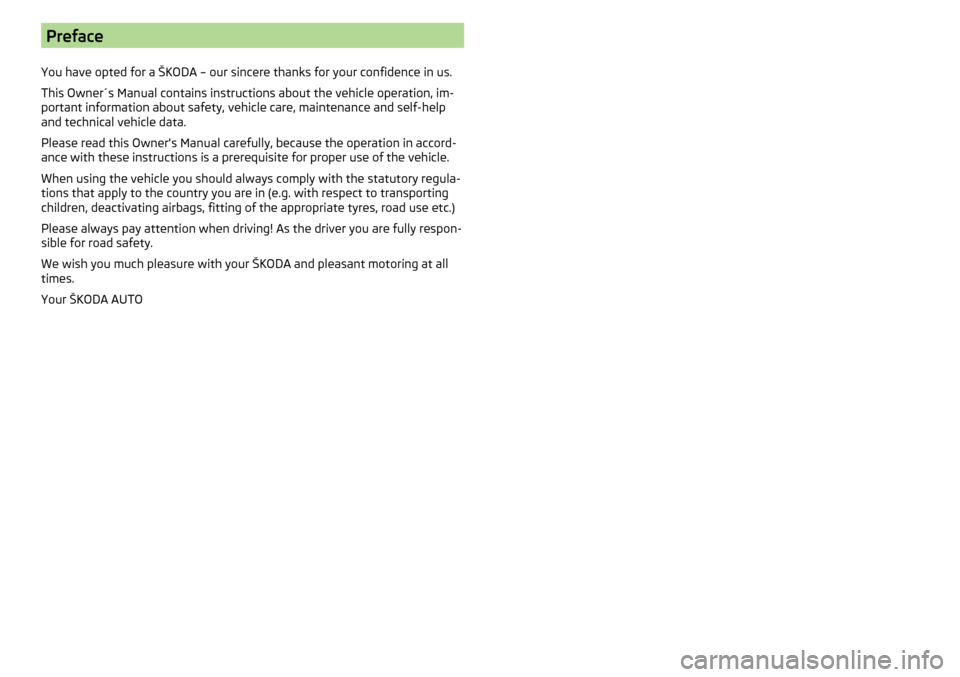
Preface
You have opted for a ŠKODA – our sincere thanks for your confidence in us.
This Owner´s Manual contains instructions about the vehicle operation, im-
portant information about safety, vehicle care, maintenance and self-help
and technical vehicle data.
Please read this Owner's Manual carefully, because the operation in accord-
ance with these instructions is a prerequisite for proper use of the vehicle.
When using the vehicle you should always comply with the statutory regula-
tions that apply to the country you are in (e.g. with respect to transporting
children, deactivating airbags, fitting of the appropriate tyres, road use etc.)
Please always pay attention when driving! As the driver you are fully respon-
sible for road safety.
We wish you much pleasure with your ŠKODA and pleasant motoring at all times.
Your ŠKODA AUTO
Page 5 of 172
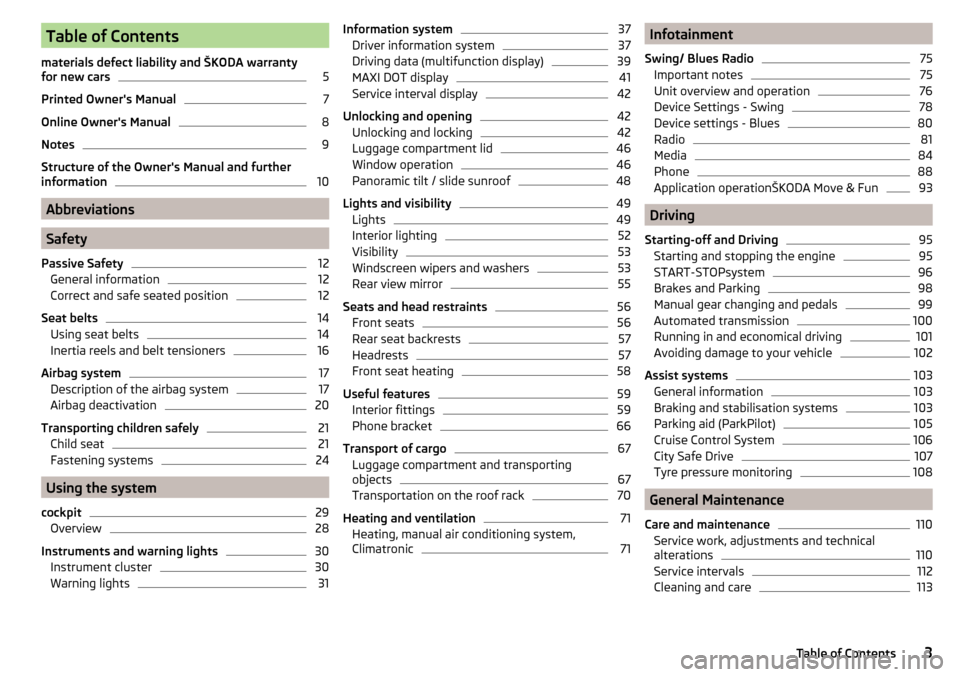
Table of Contents
materials defect liability and ŠKODA warranty
for new cars5
Printed Owner's Manual
7
Online Owner's Manual
8
Notes
9
Structure of the Owner's Manual and further
information
10
Abbreviations
Safety
Passive Safety
12
General information
12
Correct and safe seated position
12
Seat belts
14
Using seat belts
14
Inertia reels and belt tensioners
16
Airbag system
17
Description of the airbag system
17
Airbag deactivation
20
Transporting children safely
21
Child seat
21
Fastening systems
24
Using the system
cockpit
29
Overview
28
Instruments and warning lights
30
Instrument cluster
30
Warning lights
31Information system37Driver information system37
Driving data (multifunction display)
39
MAXI DOT display
41
Service interval display
42
Unlocking and opening
42
Unlocking and locking
42
Luggage compartment lid
46
Window operation
46
Panoramic tilt / slide sunroof
48
Lights and visibility
49
Lights
49
Interior lighting
52
Visibility
53
Windscreen wipers and washers
53
Rear view mirror
55
Seats and head restraints
56
Front seats
56
Rear seat backrests
57
Headrests
57
Front seat heating
58
Useful features
59
Interior fittings
59
Phone bracket
66
Transport of cargo
67
Luggage compartment and transporting
objects
67
Transportation on the roof rack
70
Heating and ventilation
71
Heating, manual air conditioning system,
Climatronic
71Infotainment
Swing/ Blues Radio75
Important notes
75
Unit overview and operation
76
Device Settings - Swing
78
Device settings - Blues
80
Radio
81
Media
84
Phone
88
Application operationŠKODA Move & Fun
93
Driving
Starting-off and Driving
95
Starting and stopping the engine
95
START-STOPsystem
96
Brakes and Parking
98
Manual gear changing and pedals
99
Automated transmission
100
Running in and economical driving
101
Avoiding damage to your vehicle
102
Assist systems
103
General information
103
Braking and stabilisation systems
103
Parking aid (ParkPilot)
105
Cruise Control System
106
City Safe Drive
107
Tyre pressure monitoring
108
General Maintenance
Care and maintenance
110
Service work, adjustments and technical
alterations
110
Service intervals
112
Cleaning and care
1133Table of Contents
Page 6 of 172
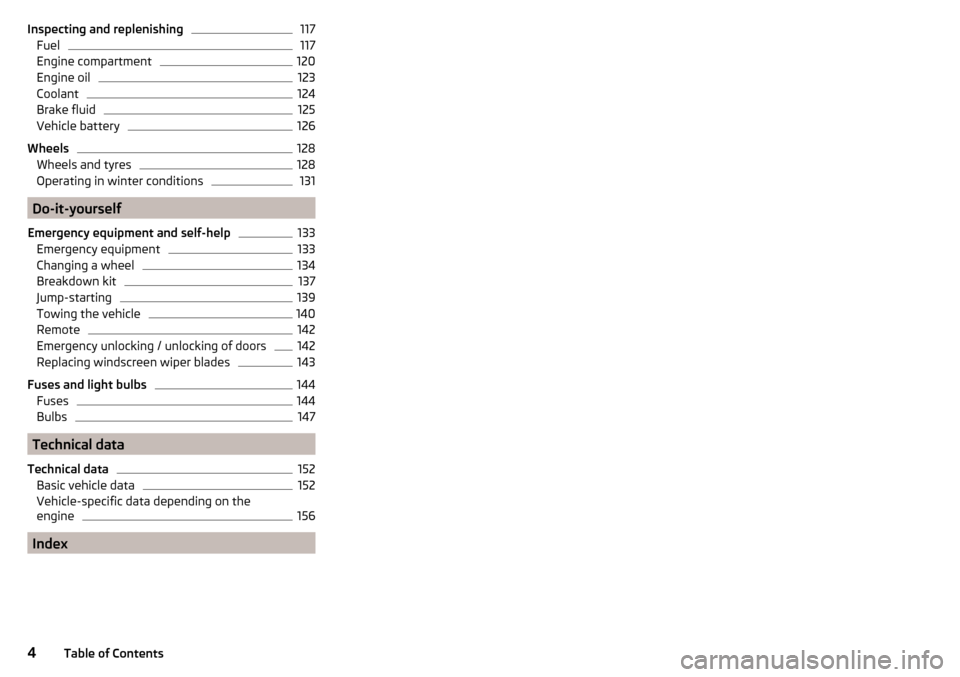
Inspecting and replenishing117Fuel117
Engine compartment
120
Engine oil
123
Coolant
124
Brake fluid
125
Vehicle battery
126
Wheels
128
Wheels and tyres
128
Operating in winter conditions
131
Do-it-yourself
Emergency equipment and self-help
133
Emergency equipment
133
Changing a wheel
134
Breakdown kit
137
Jump-starting
139
Towing the vehicle
140
Remote
142
Emergency unlocking / unlocking of doors
142
Replacing windscreen wiper blades
143
Fuses and light bulbs
144
Fuses
144
Bulbs
147
Technical data
Technical data
152
Basic vehicle data
152
Vehicle-specific data depending on the
engine
156
Index
4Table of Contents
Page 9 of 172
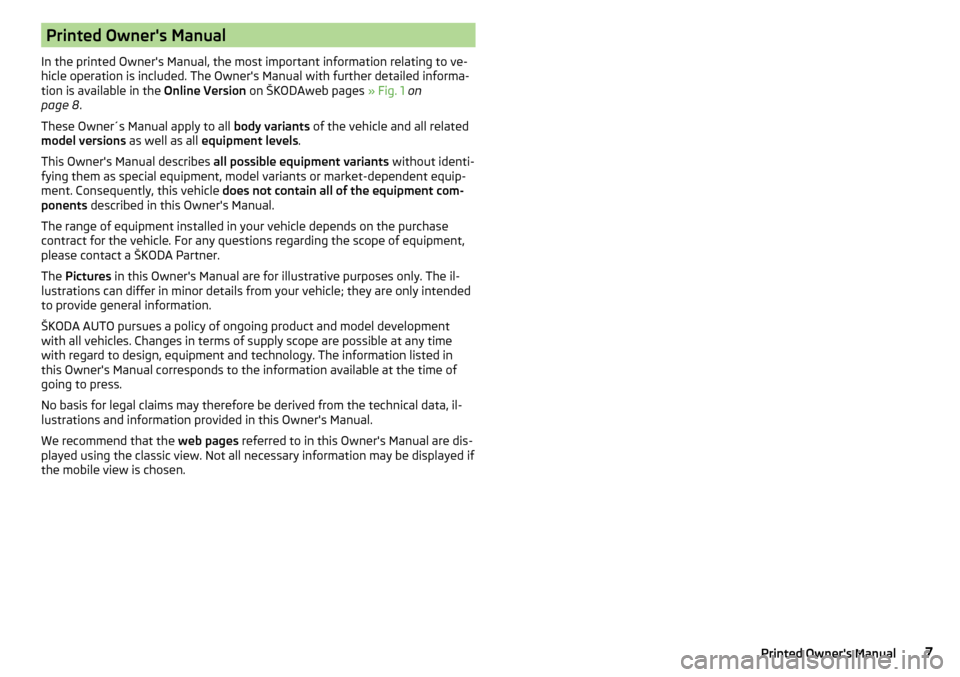
Printed Owner's Manual
In the printed Owner's Manual, the most important information relating to ve-
hicle operation is included. The Owner's Manual with further detailed informa- tion is available in the Online Version on ŠKODAweb pages » Fig. 1 on
page 8 .
These Owner´s Manual apply to all body variants of the vehicle and all related
model versions as well as all equipment levels .
This Owner's Manual describes all possible equipment variants without identi-
fying them as special equipment, model variants or market-dependent equip-
ment. Consequently, this vehicle does not contain all of the equipment com-
ponents described in this Owner's Manual.
The range of equipment installed in your vehicle depends on the purchase
contract for the vehicle. For any questions regarding the scope of equipment,
please contact a ŠKODA Partner.
The Pictures in this Owner's Manual are for illustrative purposes only. The il-
lustrations can differ in minor details from your vehicle; they are only intended
to provide general information.
ŠKODA AUTO pursues a policy of ongoing product and model development
with all vehicles. Changes in terms of supply scope are possible at any time
with regard to design, equipment and technology. The information listed in
this Owner's Manual corresponds to the information available at the time of
going to press.
No basis for legal claims may therefore be derived from the technical data, il-
lustrations and information provided in this Owner's Manual.
We recommend that the web pages referred to in this Owner's Manual are dis-
played using the classic view. Not all necessary information may be displayed if
the mobile view is chosen.7Printed Owner's Manual
Page 104 of 172
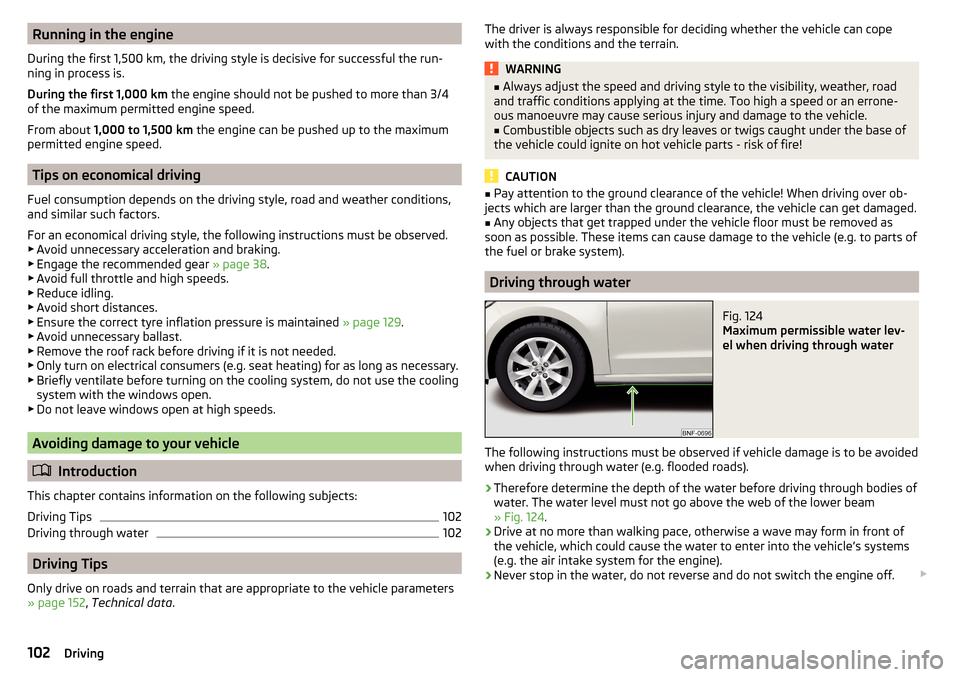
Running in the engine
During the first 1,500 km, the driving style is decisive for successful the run-
ning in process is.
During the first 1,000 km the engine should not be pushed to more than 3/4
of the maximum permitted engine speed.
From about 1,000 to 1,500 km the engine can be pushed up to the maximum
permitted engine speed.
Tips on economical driving
Fuel consumption depends on the driving style, road and weather conditions,
and similar such factors.
For an economical driving style, the following instructions must be observed. ▶ Avoid unnecessary acceleration and braking.
▶ Engage the recommended gear » page 38.
▶ Avoid full throttle and high speeds.
▶ Reduce idling.
▶ Avoid short distances.
▶ Ensure the correct tyre inflation pressure is maintained » page 129.
▶ Avoid unnecessary ballast.
▶ Remove the roof rack before driving if it is not needed.
▶ Only turn on electrical consumers (e.g. seat heating) for as long as necessary.
▶ Briefly ventilate before turning on the cooling system, do not use the cooling
system with the windows open.
▶ Do not leave windows open at high speeds.
Avoiding damage to your vehicle
Introduction
This chapter contains information on the following subjects:
Driving Tips
102
Driving through water
102
Driving Tips
Only drive on roads and terrain that are appropriate to the vehicle parameters
» page 152 , Technical data .
The driver is always responsible for deciding whether the vehicle can cope
with the conditions and the terrain.WARNING■ Always adjust the speed and driving style to the visibility, weather, road
and traffic conditions applying at the time. Too high a speed or an errone-
ous manoeuvre may cause serious injury and damage to the vehicle.■
Combustible objects such as dry leaves or twigs caught under the base of
the vehicle could ignite on hot vehicle parts - risk of fire!
CAUTION
■ Pay attention to the ground clearance of the vehicle! When driving over ob-
jects which are larger than the ground clearance, the vehicle can get damaged.■
Any objects that get trapped under the vehicle floor must be removed as
soon as possible. These items can cause damage to the vehicle (e.g. to parts of
the fuel or brake system).
Driving through water
Fig. 124
Maximum permissible water lev-
el when driving through water
The following instructions must be observed if vehicle damage is to be avoided
when driving through water (e.g. flooded roads).
›
Therefore determine the depth of the water before driving through bodies of
water. The water level must not go above the web of the lower beam
» Fig. 124 .
›
Drive at no more than walking pace, otherwise a wave may form in front of
the vehicle, which could cause the water to enter into the vehicle’s systems
(e.g. the air intake system for the engine).
›
Never stop in the water, do not reverse and do not switch the engine off.
102Driving
Page 154 of 172
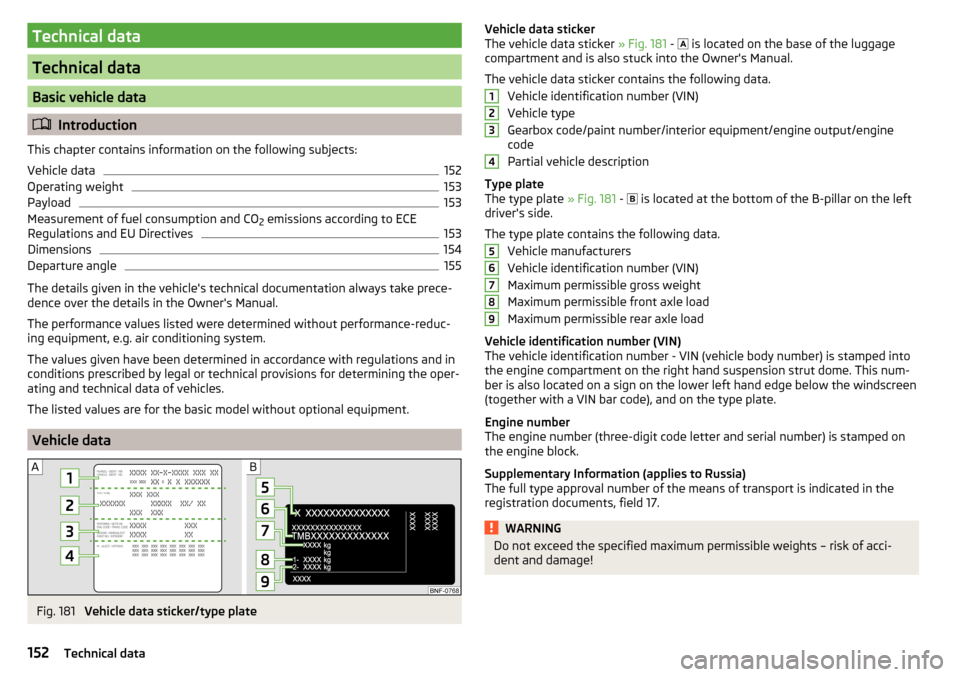
Technical data
Technical data
Basic vehicle data
Introduction
This chapter contains information on the following subjects:
Vehicle data
152
Operating weight
153
Payload
153
Measurement of fuel consumption and CO 2 emissions according to ECE
Regulations and EU Directives
153
Dimensions
154
Departure angle
155
The details given in the vehicle's technical documentation always take prece-
dence over the details in the Owner's Manual.
The performance values listed were determined without performance-reduc- ing equipment, e.g. air conditioning system.
The values given have been determined in accordance with regulations and in
conditions prescribed by legal or technical provisions for determining the oper-
ating and technical data of vehicles.
The listed values are for the basic model without optional equipment.
Vehicle data
Fig. 181
Vehicle data sticker/type plate
Vehicle data sticker
The vehicle data sticker » Fig. 181 - is located on the base of the luggage
compartment and is also stuck into the Owner's Manual.
The vehicle data sticker contains the following data. Vehicle identification number (VIN)
Vehicle type
Gearbox code/paint number/interior equipment/engine output/engine code
Partial vehicle description
Type plate
The type plate » Fig. 181 -
is located at the bottom of the B-pillar on the left
driver's side.
The type plate contains the following data. Vehicle manufacturers
Vehicle identification number (VIN)
Maximum permissible gross weight
Maximum permissible front axle load
Maximum permissible rear axle load
Vehicle identification number (VIN)
The vehicle identification number - VIN (vehicle body number) is stamped into
the engine compartment on the right hand suspension strut dome. This num-
ber is also located on a sign on the lower left hand edge below the windscreen
(together with a VIN bar code), and on the type plate.
Engine number
The engine number (three-digit code letter and serial number) is stamped on the engine block.
Supplementary Information (applies to Russia)
The full type approval number of the means of transport is indicated in the
registration documents, field 17.WARNINGDo not exceed the specified maximum permissible weights – risk of acci-
dent and damage!123456789152Technical data
Page 155 of 172
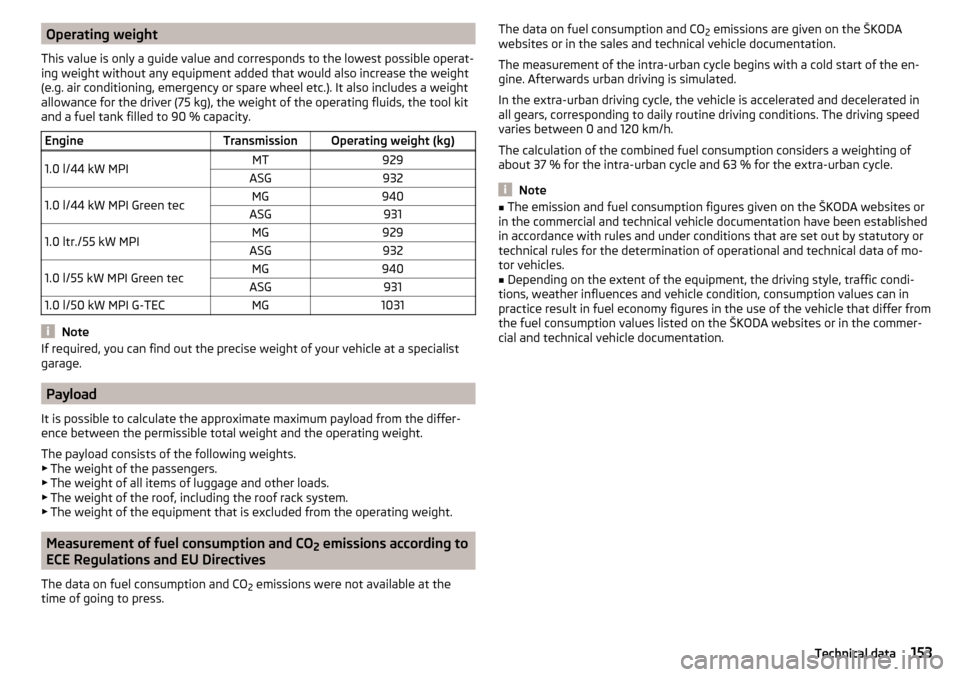
Operating weight
This value is only a guide value and corresponds to the lowest possible operat-
ing weight without any equipment added that would also increase the weight
(e.g. air conditioning, emergency or spare wheel etc.). It also includes a weight
allowance for the driver (75 kg), the weight of the operating fluids, the tool kit
and a fuel tank filled to 90 % capacity.EngineTransmissionOperating weight (kg)1.0 l/44 kW MPIMT929ASG9321.0 l/44 kW MPI Green tecMG940ASG9311.0 ltr./55 kW MPIMG929ASG9321.0 l/55 kW MPI Green tecMG940ASG9311.0 l/50 kW MPI G-TECMG1031
Note
If required, you can find out the precise weight of your vehicle at a specialist
garage.
Payload
It is possible to calculate the approximate maximum payload from the differ-
ence between the permissible total weight and the operating weight.
The payload consists of the following weights.
▶ The weight of the passengers.
▶ The weight of all items of luggage and other loads.
▶ The weight of the roof, including the roof rack system.
▶ The weight of the equipment that is excluded from the operating weight.
Measurement of fuel consumption and CO
2 emissions according to
ECE Regulations and EU Directives
The data on fuel consumption and CO 2 emissions were not available at the
time of going to press.
The data on fuel consumption and CO 2 emissions are given on the ŠKODA
websites or in the sales and technical vehicle documentation.
The measurement of the intra-urban cycle begins with a cold start of the en-
gine. Afterwards urban driving is simulated.
In the extra-urban driving cycle, the vehicle is accelerated and decelerated in
all gears, corresponding to daily routine driving conditions. The driving speed
varies between 0 and 120 km/h.
The calculation of the combined fuel consumption considers a weighting of
about 37 % for the intra-urban cycle and 63 % for the extra-urban cycle.
Note
■ The emission and fuel consumption figures given on the ŠKODA websites or
in the commercial and technical vehicle documentation have been established
in accordance with rules and under conditions that are set out by statutory or
technical rules for the determination of operational and technical data of mo-
tor vehicles.■
Depending on the extent of the equipment, the driving style, traffic condi-
tions, weather influences and vehicle condition, consumption values can in
practice result in fuel economy figures in the use of the vehicle that differ from
the fuel consumption values listed on the ŠKODA websites or in the commer-
cial and technical vehicle documentation.
153Technical data
Page 156 of 172
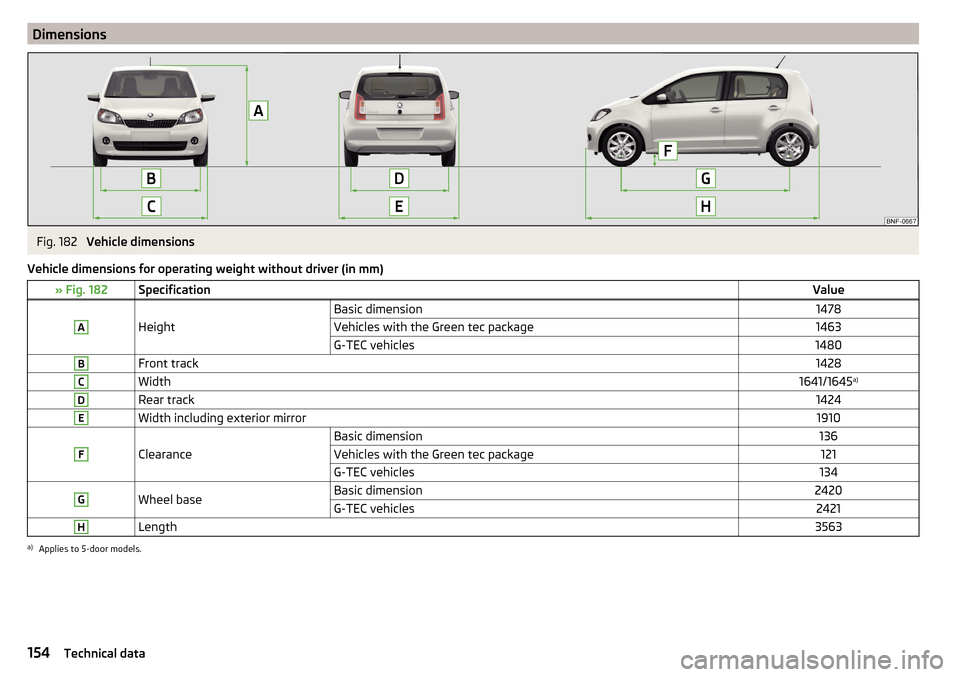
DimensionsFig. 182
Vehicle dimensions
Vehicle dimensions for operating weight without driver (in mm)
» Fig. 182SpecificationValueA
Height
Basic dimension1478Vehicles with the Green tec package1463G-TEC vehicles1480BFront track1428CWidth1641/1645 a)DRear track1424EWidth including exterior mirror1910F
Clearance
Basic dimension136Vehicles with the Green tec package121G-TEC vehicles134GWheel baseBasic dimension2420G-TEC vehicles2421HLength3563a)
Applies to 5-door models.
154Technical data
Page 157 of 172
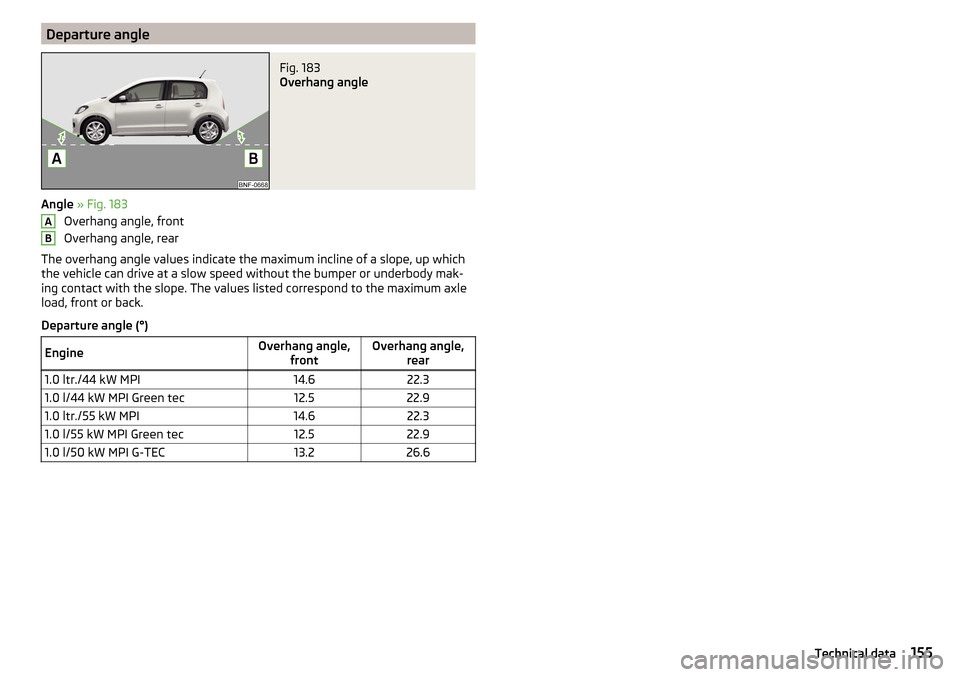
Departure angleFig. 183
Overhang angle
Angle » Fig. 183
Overhang angle, front
Overhang angle, rear
The overhang angle values indicate the maximum incline of a slope, up which the vehicle can drive at a slow speed without the bumper or underbody mak-
ing contact with the slope. The values listed correspond to the maximum axle
load, front or back.
Departure angle (°)
EngineOverhang angle, frontOverhang angle, rear1.0 ltr./44 kW MPI14.622.31.0 l/44 kW MPI Green tec12.522.91.0 ltr./55 kW MPI14.622.31.0 l/55 kW MPI Green tec12.522.91.0 l/50 kW MPI G-TEC13.226.6AB155Technical data
Page 158 of 172
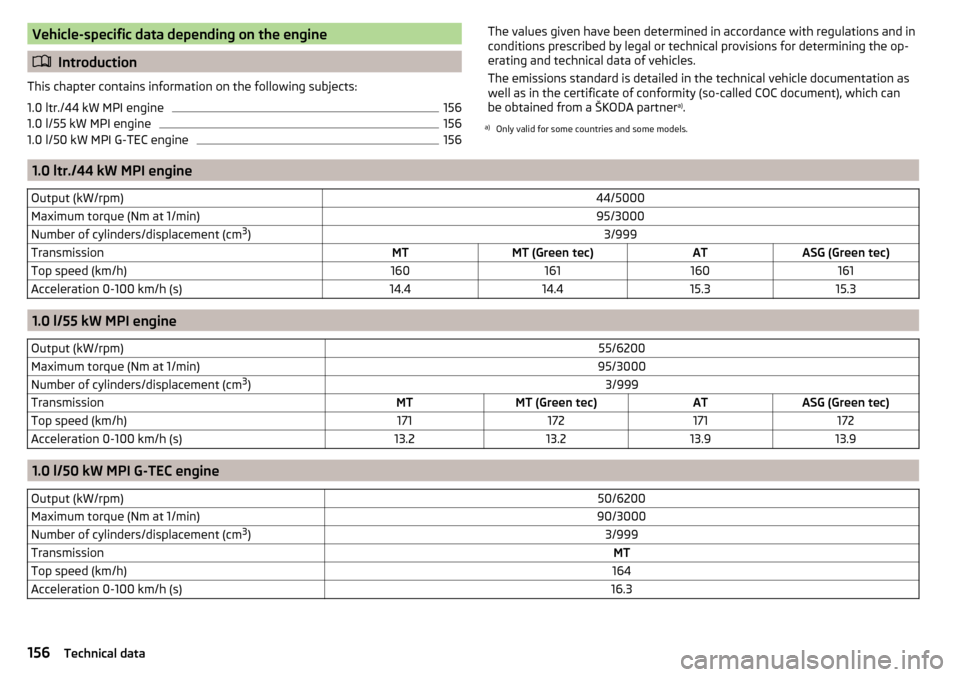
Vehicle-specific data depending on the engine
Introduction
This chapter contains information on the following subjects:
1.0 ltr./44 kW MPI engine
156
1.0 l/55 kW MPI engine
156
1.0 l/50 kW MPI G-TEC engine
156The values given have been determined in accordance with regulations and in
conditions prescribed by legal or technical provisions for determining the op-
erating and technical data of vehicles.The emissions standard is detailed in the technical vehicle documentation as
well as in the certificate of conformity (so-called COC document), which can
be obtained from a ŠKODA partner a)
.a)
Only valid for some countries and some models.
1.0 ltr./44 kW MPI engineOutput (kW/rpm)44/5000Maximum torque (Nm at 1/min)95/3000Number of cylinders/displacement (cm 3
)3/999TransmissionMTMT (Green tec)ATASG (Green tec)Top speed (km/h)160161160161Acceleration 0-100 km/h (s)14.414.415.315.3
1.0 l/55 kW MPI engine
Output (kW/rpm)55/6200Maximum torque (Nm at 1/min)95/3000Number of cylinders/displacement (cm 3
)3/999TransmissionMTMT (Green tec)ATASG (Green tec)Top speed (km/h)171172171172Acceleration 0-100 km/h (s)13.213.213.913.9
1.0 l/50 kW MPI G-TEC engine
Output (kW/rpm)50/6200Maximum torque (Nm at 1/min)90/3000Number of cylinders/displacement (cm 3
)3/999TransmissionMTTop speed (km/h)164Acceleration 0-100 km/h (s)16.3156Technical data